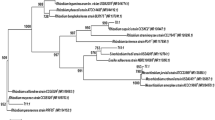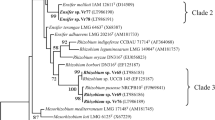Abstract
Out of a total of 8 bacterial strains isolated from the root nodules of pigeon pea plants grown in arid region, five were identified as rhizobia based on biochemical test and confirmed by 16S rDNA sequencing. PCR based screening for the rtxA gene (involved in biosynthesis of rhizobitoxine) revealed that the gene was present in one strain identified biochemically and genetically as belonging to species Bradyrhizobium (BS KT-24). The strain was resistant to phosphomycin, nalidixic acid, kanamycin, gentamicin and neomycin but sensitive towards streptomycin and spectinomycin. Bioinformatic-tool-guided phylogenetic analysis of rtxA gene revealed its distinctiveness from other known rtxA genes (present in B. japonicum, B. elkanii and Xanthomonas oryzae). The rhizobitoxine producing strain BS KT-24 is considered to exhibit better survival and nodulation protection besides competitiveness for pigeon pea and other legumes grown under abiotic stress and, thus, be a candidate in practical aspect of rhizobitoxine production by rhizobium and its application as rhizobial inoculants.
Similar content being viewed by others
References
Abeles F.B., Morgan P.W., Saltveit M.E.: Ethylene in Plant Biology. Academic Press, San Diego (USA) 1992.
Bohlool B.B., Ladha J.K., Garrity D.P., George T.: Biological nitrogen fixation for sustainable agriculture: a perspective. Plant & Soil141, 1–11 (1992).
Burd G.I., Dixon D.G., Glick B.R.: Plant growth-promoting bacteria that decrease heavy metal toxicity in plants. Can.J.Microbiol.46, 237–245 (2000).
Dahiya J.S., Khurana A.L.: ’Chillum’ jar a better technique for screening of rhizobia under summer conditions. Plant & Soil63, 299–302 (1981).
Gaur Y.D., Mareckova H.: Absence of 3-ketolactose production by Rhizobium phaseoli. Folia Microbiol.22, 311–312 (1977).
Glick B.R., Cheng Z., Czarny J., Duan J.: Promotion of plant growth by ACC deaminase-producing soil bacteria. Eur.J.Plant Pathol.119, 329–339 (2007).
Honma M., Shimomura T.: Metabolism of 1-aminocyclopropane-1-carboxylic acid. Agric.Biol.Chem.42, 1825–1831 (1978).
Hyodo H.: Stress/wound ethylene, pp. 65–80 in A.K. Mattoo, J.C. Shuttle (Eds): The Plant Hormone Ethylene. CRC Press, Boca Raton 1991.
Johnson P.R., Ecker J.R.: The ethylene gas signal transduction pathway: a molecular perspective. Ann.Rev.Genet.32, 227–254 (1998).
Kende H.: Ethylene biosynthesis. Ann.Rev.Plant Physiol.Plant Mol.Biol.44, 283–307 (1993).
Maatallah J., Berraho E.B., Munoz S., Sanjuan J., Lluch C.: Phenotypic and molecular characterization of chickpea rhizobia isolated from different areas of Morocco. J.Appl.Microbiol.93, 531–540 (2002).
Mayak S., Tirosh T., Glick B.R.: Plant growth-promoting bacteria that confer resistance to water stress in tomato and pepper. Plant Science166, 525–530 (2004a).
Mayak S., Tirosh T., Glick B.R.: Plant growth-promoting bacteria that confer resistance in tomato to salt stress. Plant Physiol.Biochem.42, 565–572 (2004b).
Minami R., Uchiyama K., Murakami T., Kawai J., Mikami K., Yamada T., Yokoi D., Ito H., Matsui H., Honma M.: Properties, sequence, and synthesis in Escherichia coli of 1-aminocyclopropane-1-carboxylate deaminase from Hansenula saturnus. J.Biochem.(Tokyo)123, 1112–1118 (1998).
Minamisawa K., Onodera S., Tanimura Y., Kobayashi N., Yuhashi K., Kubota M.: Preferential nodulation of Glycine max, Glycine soja, Macroptilium atropurpureum by two Bradyrhizobium species japonicum and elkanii. FEMS Microbiol.Ecol.24, 49–56 (1997).
Oldroyd G.E.D., Engstrom E.M., Long S.R.: Ethylene inhibits the Nod factor signal transduction pathway of Medicago truncatula. Plant Cell13, 1835–1849 (2001).
Pandey P., Kang S.C., Maheshwari D.K.: Isolation of endophytic plant growth promoting Burkholderia sp. MSSP from root nodules of Mimosa pudica. Curr.Sci.89, 170–180 (2005).
Parker M.A., Peters N.K.: Rhizobitoxine production and symbiotic compatibility of Bradyrhizobium from Asian and North American lineages of Amphicarpaea. Can.J.Microbiol.47, 1–6 (2001).
Ruan X., Peters N.K.: Isolation and characterization of rhizobitoxine mutants of Bradyrhizobium japonicum. J.Bacteriol.174, 3467–3473 (1992).
Safronova V.I., Stepanok V.V., Engqvist G.L., Alekseyev Y.V., Belimov A.A.: Root-associated bacteria containing 1-aminocyclopropane-1-carboxylate deaminase improve growth and nutrient uptake by pea genotypes cultivated in cadmium supplemented soil. Biol.Fert.Soils42, 267–272 (2006).
Saitou N., Nei M.: The neighbor joining method: a new method for reconstructing phylogenetic trees. Mol.Biol.Evol.4, 406–425 (1987).
Sambrook J., Fritsh E.F., Maniatis T.: Molecular Cloning — a Laboratory Manual, 2nd ed. Cold Spring Harbor Laboratory Press, Cold Spring Harbor-New York 1989.
Shaharoona B., Arshad M., Zahir Z.A.: Effect of plant growth promoting rhizobacteria containing ACC-deaminase on maize (Zea mays L.) growth under axenic conditions and on nodulation in mung bean (Vigna radiata L.). Lett.Appl.Microbiol.42, 155–159 (2006).
Smibert R., Krieg N.R.: Phenotypic characterization, pp. 611–651 in P. Gerhardt, R.G.E. Murray, W.A. Wood, N.R. Krieg (Eds): Methods for General and Molecular Bacteriology. American Society for Microbiology, Washington (DC) 1994.
Tamura K., Dudely J., Nei M., Kumar S.: MEGA4: molecular evolutionary genetic analysis (MEGA) software version 4.0. Mol. Biol.Evol.24, 1596–1599 (2007).
Vincent J.M.: A Manual for the Practical Study of the Root Nodule Bacteria. Blackwell Scientific Publication, Oxford-Edinburg 1970.
Yasuta T., Okazaki S., Mitsui H., Yuhashi K., Ezura H., Minamisawa K.: DNA sequence and mutational analysis of rhizobitoxine biosynthesis gene in Bradyrhizobium elkanii. Appl.Environ.Microbiol.67, 4999–5009 (2001).
Yuhashi K., Ichikawa N., Ezura H., Akao S., Minakawa Y., Nukui N., Yasuta T., Minamisawa K.: Rhizobitoxine production by Bradyrhizobium elkanii enhances nodulation and competitiveness on Marcoptilium atropurpureum. Appl.Environ.Microbiol.66, 2658–2663 (2000).
Zaheer Z.A., Ghani U., Naveed M., Nadeem S.M., Asghar H.N.: Comparative effectiveness of Pseuodomonas and Serratia sp. containing ACC deaminase for improving growth and yield of wheat (Triticum aestivum L.) under salt stressed conditions. Arch. Microbiol.191, 415–424 (2009).
Author information
Authors and Affiliations
Corresponding author
Rights and permissions
About this article
Cite this article
Kanika, Dogra, T. & Lata Biochemical and molecular characterization of a rhizobitoxine-producing Bradyrhizobium from pigeon pea plants. Folia Microbiol 55, 233–238 (2010). https://doi.org/10.1007/s12223-010-0034-5
Received:
Revised:
Published:
Issue Date:
DOI: https://doi.org/10.1007/s12223-010-0034-5




